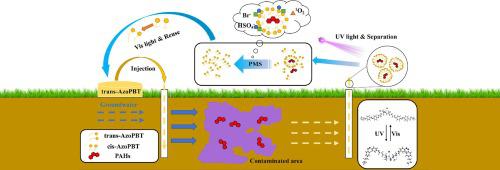Separation and Purification Technology ( IF 8.1 ) Pub Date : 2023-06-02 , DOI: 10.1016/j.seppur.2023.124242 Yueming Han , Chaomeng Dai , Jixiang Li , Zhi Li , Xueji You , Rongbing Fu , Yalei Zhang , Lang Zhou

|
Polycyclic aromatic hydrocarbons (PAHs) represent a dangerous threat to the groundwater environment. PAHs are difficult to be effectively removed from groundwater because of their hydrophobicity. In this study, a combination of a Gemini photosensitive surfactant (N1, N2-bis[4-[4-[(4-butylphenyl) azo] phenoxy] butyl]-N1, N2-tetramethylethane-1,2-diammonium bromide, AzoPBT) with peroxymonosulfate (PMS) is developed to treat PAHs-contaminated groundwater. To investigate the reaction mechanism of the PMS/AzoPBT process, we chose naphthalene (Nap) and phenanthrene (Phe) as target pollutants. The quenching experiments, electron paramagnetic resonance (EPR) spectroscopy and the identified degradation products indicated that singlet oxygen could contribute to the degradation of PAHs. A tentative solution for Phe degradation was proposed based on the degradation products. The role of surfactant micelles in the PMS/AzoPBT process is further explored. The positively charged micelles in the PMS/AzoPBT process escalate the removal of PAHs by electrostatically polymerizing Br- and HSO5- in the solution. Although increasing the number of micelles can enhance the solubilization of PAHs by surfactant solutions, the encapsulation of PAHs by micelles can “protect” PAHs, which hinders the removal of PAHs. The PMS/AzoPBT process can be applied in a broad range of pH values. In the process of recycling AzoPBT to activate PMS to remediate groundwater, PAHs can be completely removed in the first cycle, and 51.4 % of them can be removed after four times of surfactant use. The combination of photoresponsive surfactants and PMS achieves efficient oxidation of PAHs without additional activators while increasing the solubility of PAHs in groundwater. This novel technology of PAHs-contaminated groundwater treatment may provide insights into the degradation mechanism of the PMS/AzoPBT process.
中文翻译:

一石毙二鸟:光响应表面活性剂增溶PAHs激活PMS用于受污染地下水的循环修复
多环芳烃 (PAH) 对地下水环境构成危险威胁。PAHs 由于其疏水性,很难从地下水中有效去除。在这项研究中,Gemini 光敏表面活性剂 (N 1 , N 2 -bis[4-[4-[(4-butylphenyl) azo] phenoxy] butyl]-N 1 , N 2-tetramethylethane-1,2-diammonium bromide, AzoPBT) 和过氧单硫酸盐 (PMS) 被开发用于处理 PAHs 污染的地下水。为了研究 PMS/AzoPBT 过程的反应机理,我们选择萘 (Nap) 和菲 (Phe) 作为目标污染物。淬灭实验、电子顺磁共振 (EPR) 光谱和鉴定的降解产物表明单线态氧可能有助于 PAH 的降解。基于降解产物提出了Phe降解的初步解决方案。进一步探讨了表面活性剂胶束在 PMS/AzoPBT 过程中的作用。PMS/AzoPBT 过程中带正电荷的胶束通过静电聚合 Br -和 HSO 5 -来提高 PAH 的去除率在解决方案中。虽然增加胶束数量可以增强表面活性剂溶液对多环芳烃的增溶作用,但胶束对多环芳烃的包封可以“保护”多环芳烃,从而阻碍多环芳烃的去除。PMS/AzoPBT 工艺可应用于广泛的 pH 值范围。在回收AzoPBT激活PMS修复地下水的过程中,PAHs在第一个循环中就可以完全去除,表面活性剂使用4次后可以去除51.4%。光敏表面活性剂和 PMS 的组合实现了 PAHs 的有效氧化,无需额外的活化剂,同时增加了 PAHs 在地下水中的溶解度。这种处理多环芳烃污染地下水的新技术可能有助于深入了解 PMS/AzoPBT 过程的降解机制。











































 京公网安备 11010802027423号
京公网安备 11010802027423号